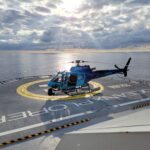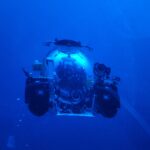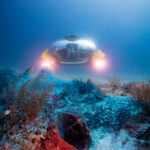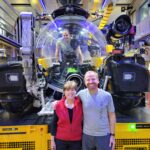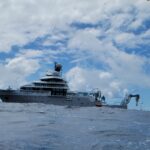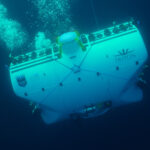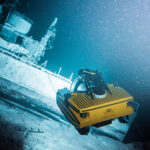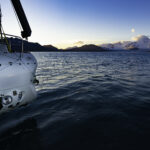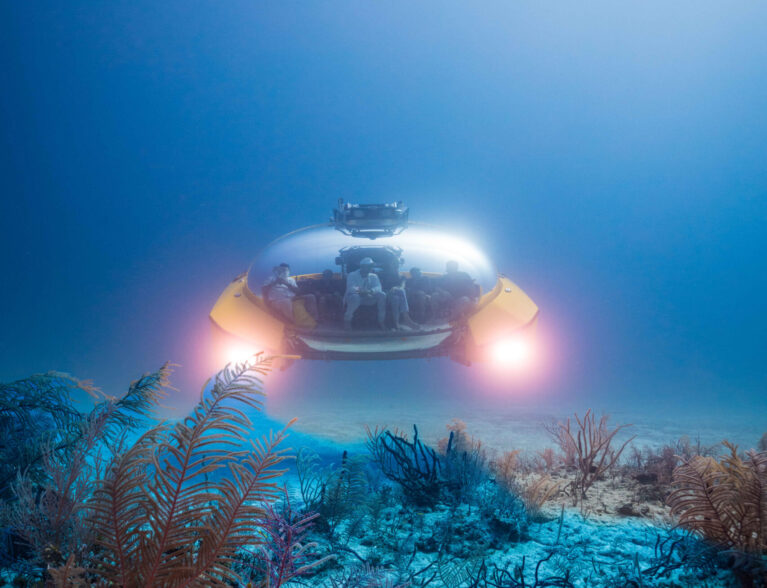
Vero’s most notable scientist, Edie Widder, was back in the national spotlight this month when “Giants of the Deep” premiered on Disney+ and Hulu.
The spectacular deep-sea documentary filmed in waters around the Azores is one episode of a six-part National Geographic series called “OceanXplorers,” produced and narrated by James Cameron.
Besides Widder, the episode features Triton submarines built in Sebastian and underwater cameras made by Artic Rays in Satellite Beach, highlighting the key role our lightly populated little stretch of coastline plays in human exploration of the deep ocean worldwide.
Widder, a marine biologist and oceanographer who has been visiting deep parts of the ocean for 40 years, gained fame in 2012 when she was the first to film the elusive giant squid, using technology she devised to lure in the mysterious and long-sought creature.
She was chief scientist on a marine mission near Chile documented by the BBC as part of “Blue Planet II,” an influential 2017 series narrated by British naturalist Sir Richard Attenborough, which has been seen by hundreds of millions of people.
Best known for her pioneering research on bioluminescence, Widder published a memoir, “Below the Edge of Darkness,” in 2021 that garnered glowing reviews and wide readership.
“Edie is the closest thing we have to a celebrity in ocean science,” said Patrick Leahy, president of Triton Submarines, and Widder is one main reason the Treasure and Space coasts have emerged as a planetary center of deep ocean exploration, on par with Woods Hole Oceanographic Institution and the Monterey Aquarium.
Lahey’s company is a second main factor.
Forbes recently called Triton the world’s “leading builder of exploratory submersibles as well as high-end personal submarines for leisure use,” and Lahey’s Jules Verne-plus undersea HOVs – human occupied vehicles – have been used “in the vast majority” of record-setting dives in recent years.
“No one is building subs that go as deep as ours and are equipped to carry such a broad suite of tools and equipment,” Lahey told Vero Beach 32963 last week. “And we have a perfect safety record.”
When private equity investor and adventurer Victor Lance Vescovo undertook the Five Deeps Expedition, becoming the first person to dive to the deepest spots in all the oceans in 2018-19, he was in a Triton 36000/2 submarine.
Likewise, when famed entrepreneur and explorer Larry Connor descended to a record-breaking depth of 35,876 feet in the Mariana Trench, it was in a Triton sub.
The OceanXplorer, the most advanced marine exploration and media vessel in the world, which Widder said was built to be a kind of Starship Enterprise of the oceans, carries two Triton ultra-high-tech submersibles with clear acrylic bubble cockpits and fantastic arrays of research and recording equipment.
InkFish, a game-changing nonprofit founded in 2021 to further ocean research that just acquired camera-maker Artic Rays, also has two Triton subs, including one that has no depth limit and can go anywhere in the world’s oceans.
“We are in a new age of HOV technology that is thrilling and deeply necessary,” said Lahey. “Every aspect has improved dramatically in recent years, from materials to batteries to lighting, imaging and collection tools.”
The rapidly advancing technology of undersea exploration is being driven forward in part by a roster of suppliers and subcontractors located between Cape Canaveral and Fort Pierce that support the work of Widder, Triton and other deep-sea players.
“We are extraordinarily fortunate to be able to draw on such a pool of passionate, talented engineers and entrepreneurs,” said Lahey, adding that our coast is “a critically important part” of the worldwide effort to explore and understand the oceans.
The U.S. has many great maritime cities, from Seattle to Miami, from Boston to San Diego, with huge populations, vast industrial infrastructure and leading research universities. So, how did our little stretch of coast outstrip those cities to become a leading locus of ocean exploration?
Two men are responsible: John Kennedy, who put the full power of the presidency behind the space program in the early 1960s, and Edwin Link, co-founder of Harbor Branch Oceanographic Institute in Fort Pierce, who created one of the world’s first submersibles.
The Johnson Sea-Link Submersibles – JSLs for short – could descend to a depth of 3,000 feet, far deeper than people had ever been able to go before.
Paired with three research ships that carried them to distant parts of the globe, the small research submarines opened up vast parts of the world to exploration that had previously been utterly unknown.
“Between 1971 and 2010 we made over 9,400 dives around the world,” Harbor Branch research professor John Reid said in a lecture several years ago.
Financial problems caused Harbor Branch’s great era of manned/womaned ocean exploration to founder early in the 21st century and researchers and engineers who had been involved in the program fanned out to other enterprises along the Treasure and Space Coasts, blending in with the teeming cadre of scientists, engineers and technicians constellated around Cape Canaveral and the space program.
“It all started with Ed Link, and then we had the Space Coast technologists as a further incubator,” said Widder.
Widder, Lahey and Lee Frey, cofounder and chief engineer of Arctic Rays, all worked at Harbor Branch earlier in their careers, along with other key people in their organizations.
“Many of the people who helped us found Triton Submarines and still work here came from Harbor Branch,” Lahey said. “We also have eight or 10 from Florida Institute of Technology, including students who started as interns and became employees.”
The technical ability of Triton’s suppliers has been fueled by the Melbourne-based university, too. FIT graduate Matt Henderson is director of engineering at Falcon Marine in Titusville, which fabricates ballast tanks and other high-tech composite components for Triton’s science-fiction submersibles.
FIT was founded in 1958 as Brevard Engineering College, offering classes to upgrade the skills of engineers, technicians and scientists at NASA. As it developed with a focus on aerospace it also branched out into ocean research and technology.
The department of oceanography was founded in 1966, and the first marine research vessel was acquired in 1968. The ocean engineering program launched in 1971 and by 2024 it was ranked among the top 10 ocean engineering programs in the country, sending ripples of expertise through the region.
NASA currently has a major research program underway using an unmanned robotic submarine called Orpheus to explore the deepest, darkest corners of the ocean to prepare for underwater exploration on other planets, such as Europa, a water-laden moon of Jupiter with twice as much ocean as earth, and Mars, where a large undersurface reservoir was just detected.
The Orpheus program – named after the legendary Greek poet and prophet who went down into the underworld to rescue his wife Eurydice – shows how interconnected the exploratory spirit and technological skill of the space program and deep-sea exploration are.
NASA is partnering with Woods Hole in the underwater effort and the probe itself is made partly of high-tech material left over from the construction of James Cameron’s Deepsea Challenger, an ocean exploration vessel he helped design that descended to the Mariana Trench in 2012.
“The ocean floor is a great testbed for us to develop the technology we need in order to have a successful mission to one of these ocean worlds,” Russell Smith a NASA engineer who is part of the Orpheus team told the BBC in 2022.
Despite the human and technological cross-fertilization, Widder and Lahey diverge from NASA and much of current ocean exploration in an important regard.
NASA – and Harbor Branch these days – use robots called autonomous underwater vehicle or AUVs to gather information in the deep ocean, while Triton, Widder and filmmakers like Cameron are mainly focused on human exploration made possible by the latest generation of submersibles.
“It is the human element of being in a submersible that is paramount to facilitating a true understanding of our oceans,” according to Cameron.
Lahey, too, said there is no substitute for the acuity of human perception and consciousness in the act of exploration, in part because of the impact on the people involved.
Cameron was inspired to become an undersea explorer by the films of Jacques Cousteau, the first to bring the wonders under the waves to a wide audience.
In turn, his productions, like “Giants of the Deep,” inspire millions of other people to care about protecting the oceans and their amazing inhabitants.
According to pollsters, more than half of the people who saw “Blue Planet II” said the experience dramatically changed their thinking and behavior, including stopping their use of disposable plastic products.
“Jim has told me that he makes feature films to support his documentaries,” said Lahey, who has known and periodically worked with Cameron for 25 years.
Cameron has said that he made the film “Titanic” not mainly out of a love of melodrama but to generate a revenue stream that would enable him to tech up and dive to the famous wreck and see it with his own eyes.
Billionaires who first went down in Triton submersibles for fun have followed a similar course, becoming captivated by the beauty of the underwater world and devoting much of their lives thereafter to exploration and communication aimed at understanding and protecting the oceans – which Widder calls “our life support machinery.”
Ray Dalio was running the biggest hedge fund in the world when he first went down in a submersible. He has since founded the exploration and filmmaking enterprise OceanX to “illuminate life-changing secrets hiding in the deep,” created the Starship Enterprise-like OceanXplorer research ship where Widder spent a month filming “Giants of the Deep,” and become a shareholder in Triton submarines.
“Ray has decided he wants to devote his remaining time on the planet to this effort,” Lahey said.
Earth’s oceans cover 70 percent of the planet, make half the oxygen, sequester vast amounts of carbon, provide new medicines and tremendous quantities of food and are the world’s main conduit of commercial transport, “with 76 percent of U.S. trade involving some form of marine transportation,” according to NOAA.
But they remain mostly unexplored.
“We used to say that only five percent of the ocean had been explored,” said Widder. “Now with new sonar and underwater craft, it may be more like 30 percent, but very little of that is actually explored. It is mapped but has never been visited.”
Knowledge of that 30 percent is comparable to an aerial photo of a steep, wooded mountain range. The photo provides some basic information but nothing remotely like the knowledge that could be gathered by researchers hiking in, exploring, observing, looking under rocks and inside caves, cataloging life forms and behaviors.
Widder said that if the oceans were the size of the United States, the part that has actually been explored is the size of Delaware – 1982 square miles out of 3,809,525 square miles.
“The ocean is the largest space on our planet and a hugely important part of the machinery of life,” Widder added. “But we don’t understand how it works.”
“We are curious beings and there is a big part of our world that remains unexplored,” said Lahey. “That is a mistake. The things you learn about your own planet and species may have unexpected value.”
“We’re entering an exciting new age of technically enabled ocean exploration reliant on a new suite of marine vehicles, advanced imaging systems and other tech that will propel ocean science,” said Cameron. “There are mysteries to solve, new discoveries to make and critical knowledge to acquire.”
Awareness of Indian River County’s critical role in ocean exploration continues to expand. Besides the new documentaries now airing on Hulu and Disney+, the cover of the September issue of National Geographic Magazine will feature a Triton sub, and a film by award-winning documentarian Tasha Van Zandt about Widder called “A Life Illuminated” is slated to wrap up production by the end of the year.
Photos provided

